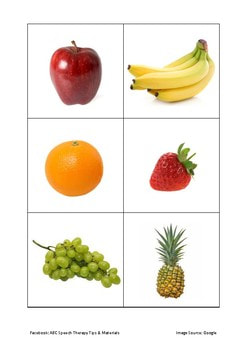|
THE VERY HUNGRY CATERPILLAR by Eric Carle is a picture book classic which children all around the world are familiar with. The familiarity of the story along with the simple language and colorful artwork make it an absolute must-have for the ESL teacher. It can be used to teach numbers, days of the week, colors, or (how I used it this year) to teach the names of fruit. After reading aloud THE VERY HUNGRY CATERPILLAR, I introduced fruit words using flashcards similar to these ones below which are a free printable through TEACHERS PAY TEACHERS - (though I like mine bigger). Game 1: I filled a big cardboard boxed with a mix of plastic fruit (one of each we introduced) and small plastic balls. One by one, students took turns "fishing" for the fruit with their eyes closed, and placing them on the corresponding flashcard. I know this game sounds so simple, but my 3-6 year olds love it. It's a great sensory game, and really gets their young neurons firing.
You can make this game harder or easier by either allowing them to look with their eyes AND hands, or blindfolding them. OR by giving students a particular fruit to search for. OR making them guess which fruit they have in their hands only by touch. Game 2: After each student had a turn with the box, we made an obstacle course. This allowed us to practice our fruit vocabulary by still building on the ACTION VERBS we introduced a few weeks back. Students were lined up on one end of the room. The fruit was lined up at the other. I also laid a broom on the ground as our main obstacle. One by one, students took turns JUMPING over the broom, TIPTOEING toward the fruit, choosing the fruit which I called out, and RUNNING back to the line. My obstacle course was very simple, but you can add to it or change it to suit your needs. For our table activity, students completed a fruit coloring page. This one below available for a free download would be a good one to try if you only want to introduce the fruit in THE VERY HUNGRY CATERPILLAR.
0 Comments
As the school year wraps up (and these little ones have been conquering more English than I ever thought they would due to our limited time) we've reached the fun topic of ACTION VERBS. For this mini-unit, I used CLAP YOUR HANDS by Lorinda Bryan Cauley. The book includes all sorts of fun actions for the kids to do, clapping hands, stomping feet, roaring like a lion, etc. And the adorable illustrations are filled with delicious details ideal for gazing. I highly recommend this book for teachers looking to get their kids up and moving.
We followed this book by introducing the basic phrases, "I can" and "I can't." Then using flashcards for the following action words, we decided what "we can" and "can't" do. Swim Fly Hop Run Walk Spin Ride a Bike Tiptoe After this, we followed with a rousing game of TEACHER SAYS. This one can be a challenge to explain to young ESL learners, so I've found the best way to approach it is to model the activity right away. Once the children understand how it works, they LOVE this game. I usual don't play "elimination style" right away, and never at all with the littlest ones. We finished our activity with a modified version of RED LIGHT GREEN LIGHT or the Italian version UN, DUE, TRE STELLA! Instead of just moving towards the "leader", students had to complete the actions I called out. |
ABOUT MEIn addition to being a writer, I have about the best job in the world. I teach 3-6 year olds English in an Italian preschool. I LOVE using picture books in my ESL lessons as introductions to my daily topics, and just because kids love books. My goal with this blog isn't to highlight the most "of-the-moment" picture books, but rather to present books that work well for ESL learners and that are accessible to teachers living all around the world. If you're an ESL teacher who loves books, then this blog is for you. Archives
April 2024
|




